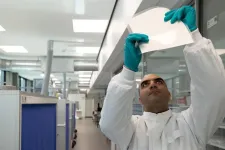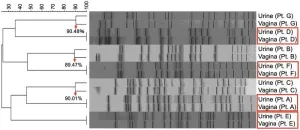(Press-News.org) In 10 years, solid-state batteries made from rock silicates will be an environmentally friendly, more efficient and safer alternative to the lithium-ion batteries we use today. Researcher at DTU have patented a new superionic material based on potassium silicate - a mineral that can be extracted from ordinary rocks.
It is the battery in your electric car that determines how far you can drive on one charge and how quickly you can re-charge. However, the lithium-ion battery, the most widely used electric car battery today, has its limitations— in terms of capacity, safety and also availability. Because lithium is an expensive, environmentally harmful material and the scarcity of the relatively rare metal can hinder the green transition of car transport.
As more and more people switch to electric cars, we need to develop a new generation of lithium-free batteries, which are at least as efficient, but more eco-friendly and cheaper to produce. This requires new materials for the battery’s main components; anode, cathode, and electrolyte, as well as developing new battery designs.
It is a research field that is currently occupying researchers all over the world, because when we find new ‘recipes’ for batteries, it will enable a significant reduction of the transport sector’s carbon emissions.
At DTU, researcher Mohamad Khoshkalam has invented a material that has the potential to replace lithium in tomorrow’s super battery: solid-state batteries based on potassium and sodium silicates. These are rock silicates, which are some of the most common minerals in the Earth’s crust. It is found in the stones you pick up on the beach or in your garden. A great advantage of the new material is that it is not sensitive to air and humidity. This makes it possible to mould it into a paper-thin layer inside the battery.
Patented superionic material
The potential of the milky-white, paper-thin material based on potassium silicate is huge. It is an inexpensive, eco-friendly material that can be extracted from silicates, which cover over 90 per cent of the Earth’s surface. The material can conduct ions at around 40 degrees and is not sensitive to moisture.
This will make scaling up and future battery production easier, safer and cheaper, as production can take place in an open atmosphere and at temperatures close to room temperature. The material also works without the addition of expensive and environmentally harmful metals such as cobalt, which is currently used in lithium-ion batteries to boost capacity and service life.
“The potential of potassium silicate as a solid-state electrolyte has been known for a long time, but in my opinion has been ignored due to challenges with the weight and size of the potassium ions. The ions are large and therefore move slower,” says Mohamad Khoshkalam.
To understand the perspectives of Mohamad Khoshkalam’s discovery, one must first understand the crucial role the electrolyte plays in a battery. The electrolyte in a battery can be a liquid or a solid material—a so-called solid-state electrolyte. The electrolyte allows the ions to move between the battery’s anode and cathode, thereby maintaining the electrical current generated during discharging and charging. In other words, the electrolyte is crucial for the battery capacity, charging time, lifespan, and safety.
The electrolyte’s conductivity depends on how fast the ions can move in the electrolyte. The ions in rock silicates generally move slower than the ions in lithium-based liquid electrolytes or solid-state electrolytes, as they are larger and heavier. But Mohamad Khoshkalam has found a recipe for a superionic material of potassium silicate and a process that makes the ions move faster than in lithium-based electrolytes.
“The first measurement with a battery component revealed that the material has a very good conductivity as a solid-state electrolyte. I cannot reveal how I developed the material, as the recipe and the method are now patented,” Mohamad Khoshkalam continues.
The battery everyone is waiting for
Both researchers and electric car manufacturers consider solid-state batteries to be the super battery of the future. Most recently, Toyota has announced that they expect to launch an electric car with a lithium solid-state battery in 2027-28. However, several car manufacturers have previously announced electric cars with solid-state batteries, only to subsequently pull out.
In a solid-state battery, the ions travel through a solid material and not through a liquid, as in the regular AA+ lithium-ion batteries you can buy in the supermarket. There are several advantages to this; the ions can move faster through a solid material, making the battery more efficient and faster to charge.
A single battery cell can be made as thin as a piece of cardboard, where the anode, cathode, and solid-state electrolyte are ultra-thin layers of material. This means that we can make more powerful batteries that take up less space. This offers benefits on the road, as you will be able to drive up to 1,000 km on a single 10-minute charge. In addition, a solid-state battery is more fireproof, as it does not contain combustible liquid.
Before we see the solid-state battery on the market, however, there are several challenges that need to be solved. The technology works well in the laboratory, but is difficult and expensive to scale up. Firstly, materials and battery research is both complex and time-consuming because the materials are super sensitive and require advanced laboratories and equipment. The lithium-ion batteries we use today took over 20 years to develop, and we’re still developing them.
Secondly, we need to develop new ways of producing and sealing the batteries so the ultra-thin material layers in the battery cell do not break and have continuous contact in order to work. In the laboratory, you solve it by pressing the layers of the battery cell together at high pressure, but it is difficult to transfer to a commercial electric car battery, which consists of many battery cells.
Solid-state rock battery is high-risk technology
Unlike lithium solid-state batteries, solid-state batteries based on potassium and sodium silicates have a low TRL (Technology Readiness Level). This means there is still a long way to go from discovery in the lab to getting the technology out into society and making a difference. The earliest we can expect to see them in new electric cars on the market is 10 years from now.
It is also a high-risk technology, where the chance of commercial success is small and the technical challenges are many. Nevertheless, Mohamad Khoshkalam is full of optimism:
“We have shown that we can find a material for a solid-state electrolyte that is cheap, efficient, eco-friendly, and scalable—and that even performs better than solid-state lithium-based electrolytes.”
A year after the discovery in the laboratory at DTU, Mohamad Khoshkalam has obtained a patent for the recipe and is in the process of establishing the start-up K-Ion, which will develop solid-state electrolyte components for battery companies. The K-ion is part of the DTU Earthbound initiative, where they receive support to get their research out of the laboratory faster and into society to make an impact.
The next step for Mohamad Khoshkalam and his team is to develop a demo battery that can show companies and potential investors that the material works. A prototype is expected to be ready within 1-2 years.
FACTS
The technology of a battery
A battery works by converting chemical energy into electrical energy. It consists of three components: a positive electrode (cathode), a negative electrode (anode), and an electrolyte.
When the battery is connected to a device, a chemical reaction releases electrons at the anode. These electrons travel through an outer circuit and deliver power to the device, while the positive ions travel through the electrolyte to the cathode, where they react with the released electrons to form a new chemical compound.
This process continues until the chemical energy in the battery is depleted. Once discharged, the battery can be recharged by supplying external electrical energy, which reverses the reaction and restores the original chemical compounds in the battery.
A lithium-ion battery works by moving lithium ions through an electrolyte liquid from the cathode (made of a mix of metals including lithium and cobalt) to the anode (made from graphite). Lithium-ion and potassium-ion batteries work in the same way. Here, lithium has simply been replaced with potassium. Research is also being conducted into sodium-ion, aluminium-ion, and magnesium-ion batteries.
In a solid-state battery, the ions do not travel through an electrolyte liquid, but rather an ultra-thin, solid material called a solid-state electrolyte. This material can be made of lithium, sodium, potassium, in the form of oxides and sulfides.
FACTS
The batteries of the future
Now: Lithium-ion batteries in improved versions
It is hard to beat lithium’s ability to conduct ions, but the material is expensive and difficult to obtain. We will see new, improved lithium-ion batteries with a lower concentration of cobalt and lithium.
Within 5 years: Sodium-ion and potassium-ion batteries, as well as lithium solid-state batteries
Sodium and potassium-ion batteries have a high TRL (Technology Readiness Level). Several automakers expect to mass-produce it within 5 years. The development of lithium solid-state batteries is further ahead. We will therefore see them on the market before potassium and sodium solid-state batteries.
Earliest from 10 years: Solid-state batteries of rock silicates
Potassium and sodium solid-state batteries have a low TRL. This means that many steps must be taken before the battery can be commercialized. The technology works in the laboratory, but several technical challenges must be solved before the technology can be scaled up into a functional electric car battery that can be mass-produced.
END
Tomorrow’s super battery for electric cars is made of rock
In 10 years, solid-state batteries made from rock silicates may be an alternative to the lithium-ion batteries we use today. DTU-researcher has patented a new material that can be extracted from ordinary rocks.
2024-07-19
ELSE PRESS RELEASES FROM THIS DATE:
Fecal immunochemical test screening and risk of colorectal cancer death
2024-07-19
About The Study: In this nested case-control study, completing fecal immunochemical test was associated with a lower risk of overall death from colorectal cancer, particularly in the left colon, and the associations were observed across racial and ethnic groups. These findings support the use of fecal immunochemical test in population-based screening strategies.
Corresponding Author: To contact the corresponding author, Chyke A. Doubeni, M.D., M.P.H., email chyke.doubeni@osumc.edu.
To access the embargoed ...
Long-term use of oral corticosteroids and safety outcomes for patients with atopic dermatitis
2024-07-19
About The Study: Oral corticosteroid use of more than 90 days per year among individuals with atopic dermatitis was associated with a small increased risk of composite adverse outcomes in this large population-based case-control study. Future investigations are warranted to confirm this potential risk of adverse events (AEs) associated with long-term use of oral corticosteroids for patients with exacerbations of atopic dermatitis, and health care professionals should thoroughly weigh the benefits associated with oral corticosteroids ...
Diagnosing solid lesions in the pancreas with multimodal AI
2024-07-19
About The Study: In this randomized crossover trial of diagnosing solid lesions in the pancreas with or without artificial intelligence (AI) assistance, the joint-AI model demonstrated positive human-AI interaction, which suggested its potential to facilitate a clinical diagnosis. Nevertheless, future randomized clinical trials are warranted.
Corresponding Authors: To contact the corresponding authors, email Aiming Yang, M.D. (yangaiming@medmail.com.cn) and Bin Cheng, M.D. (b.cheng@tjh.tjmu.edu.cn).
To access the embargoed study: Visit our For The Media website at this link https://media.jamanetwork.com/
(doi:10.1001/jamanetworkopen.2024.22454)
Editor’s ...
Trillions lost in worker productivity due to eco anxiety and ‘lie-back’ lifestyles
2024-07-19
Could nature and climate anxieties predict future social behaviours, in the same way that consumer sentiment predicts purchasing and investment?
The suggestion is made in the Cell Press journal One Earth, by Griffith University’s Professor Emeritus Ralf Buckley, in a preview of an article led by Professor Thomas Pienkowski in the UK.
Professor Buckley said the international Global Burden of Disease Study had shown that anxiety and depression were widespread and worsening.
“Economic costs are up to 16% of global GDP, with 19 days per year on average lost ...
University of Cincinnati study examines impact of incarceration on youth health
2024-07-19
Researcher Samantha Boch has studied the impact of incarceration on child and family health for more than a decade.
Her latest research examines the health records and health care use of youth, individuals under age 21, who likely have been involved or whose families have been involved in the justice system. The challenge was identifying youth who have been impacted by mass incarceration, as most health care systems don’t routinely ask about incarceration. Families may not disclose that information due to stigma, fear of child protective services involvement, ...
Wetland wonders unfold: Aerial systems shed light on ecosystem services
2024-07-19
A cutting-edge study revolutionizes coastal wetland mapping by integrating unmanned aerial systems with light detection and ranging (LiDAR) and multispectral sensors. This innovative approach provides detailed elevation data and vegetation analysis, enabling highly accurate classifications of diverse wetland types. The research advances conservation by offering a scalable, efficient, and cost-effective method that is instrumental in climate change mitigation strategies and informs policy-making for coastal resilience.
Coastal wetlands, situated at the junction of land and water, are vital ecosystems known for their high productivity. They play a key role in carbon ...
New discovery adds to story of ancient human migration
2024-07-19
New evidence of human occupation in southeast Indonesia dating back 42,000 years offers fresh clues on the route taken by some of the first humans to arrive in our region, according to a study from The Australian National University (ANU).
Lead author and ANU PhD candidate Hendri Kaharudin said the location of the discovery -- at Elivavan on Indonesia’s Tanimbar islands -- makes it especially significant.
“Tanimbar is located just off the ‘Sahul shelf’, which encompasses modern-day Australia, as well as New Guinea,” he said.
“The question ...
A tale of two “niches”: The microbial connection between urinary bladder and vagina
2024-07-19
The human body hosts a diverse array of microorganisms that maintain a delicate balance crucial for overall health. This microbial harmony can be disrupted by factors like infections, aging, and hormonal changes, leading to dysbiosis—a condition where microbial communities become imbalanced and harmful to health. Postmenopausal women, for instance, are particularly susceptible to recurrent urinary tract infections and inflammation, including cystitis, due to these microbial shifts.
Dr. Takanori Sekito from the Department of Urology, Okayama University Graduate School of Medicine, Japan explains, “In postmenopausal women, the vaginal flora changes ...
Chemists design novel method for generating sustainable fuel
2024-07-19
COLUMBUS, Ohio – Chemists have been working to synthesize high-value materials from waste molecules for years. Now, an international collaboration of scientists is exploring ways to use electricity to streamline the process.
In their study, recently published in Nature Catalysis, researchers demonstrated that carbon dioxide, a greenhouse gas, can be converted into a type of liquid fuel called methanol in a highly efficient manner.
This process happened by taking cobalt phthalocyanine (CoPc) molecules and spreading them evenly on carbon nanotubes, graphene-like tubes that have unique electrical properties. On their surface was an electrolyte ...
ETRI breathes digital life into cultural heritage
2024-07-19
South Korean researchers are revitalizing the nation's world-class cultural heritage through digital transformation. By collaborating with museums, they are bringing the rich history and culture of Korea to life using AI-based technology development.
Since 2020, the Electronics and Telecommunications Research Institute (ETRI) and the National Museum of Korea have been working together under a Ministry of Culture, Sports and Tourism R&D project to develop and demonstrate key technologies for the digital transformation of Korean cultural heritage.
The two institutions have been applying ...
LAST 30 PRESS RELEASES:
Interaction of climate change and human activity and its impact on plant diversity in Qinghai-Tibet plateau
From addressing uncertainty to national strategy: an interpretation of Professor Lim Siong Guan’s views
Clinical trials on AI language model use in digestive healthcare
Scientists improve robotic visual–inertial trajectory localization accuracy using cross-modal interaction and selection techniques
Correlation between cancer cachexia and immune-related adverse events in HCC
Human adipose tissue: a new source for functional organoids
Metro lines double as freight highways during off-peak hours, Beijing study shows
Biomedical functions and applications of nanomaterials in tumor diagnosis and treatment: perspectives from ophthalmic oncology
3D imaging unveils how passivation improves perovskite solar cell performance
Enriching framework Al sites in 8-membered rings of Cu-SSZ-39 zeolite to enhance low-temperature ammonia selective catalytic reduction performance
AI-powered RNA drug development: a new frontier in therapeutics
Decoupling the HOR enhancement on PtRu: Dynamically matching interfacial water to reaction coordinates
Sulfur isn’t poisonous when it synergistically acts with phosphine in olefins hydroformylation
URI researchers uncover molecular mechanisms behind speciation in corals
Chitin based carbon aerogel offers a cleaner way to store thermal energy
Tracing hidden sources of nitrate pollution in rapidly changing rural urban landscapes
Viruses on plastic pollution may quietly accelerate the spread of antibiotic resistance
Three UH Rainbow Babies & Children’s faculty elected to prestigious American Pediatric Society
Tunnel resilience models unveiled to aid post-earthquake recovery
Satellite communication systems: the future of 5G/6G connectivity
Space computing power networks: a new frontier for satellite technologies
Experiments advance potential of protein that makes hydrogen sulfide as a therapeutic target for Alzheimer’s disease
Examining private equity’s role in fertility care
Current Molecular Pharmacology achieves a landmark: real-time CiteScore advances to 7.2
Skeletal muscle epigenetic clocks developed using postmortem tissue from an Asian population
Estimating unemployment rates with social media data
Climate policies can backfire by eroding “green” values, study finds
Too much screen time too soon? A*STAR study links infant screen exposure to brain changes and teen anxiety
Global psychiatry mourns Professor Dan Stein, visionary who transformed mental health science across Africa and beyond
KIST develops eco-friendly palladium recovery technology to safeguard resource security
[Press-News.org] Tomorrow’s super battery for electric cars is made of rockIn 10 years, solid-state batteries made from rock silicates may be an alternative to the lithium-ion batteries we use today. DTU-researcher has patented a new material that can be extracted from ordinary rocks.






